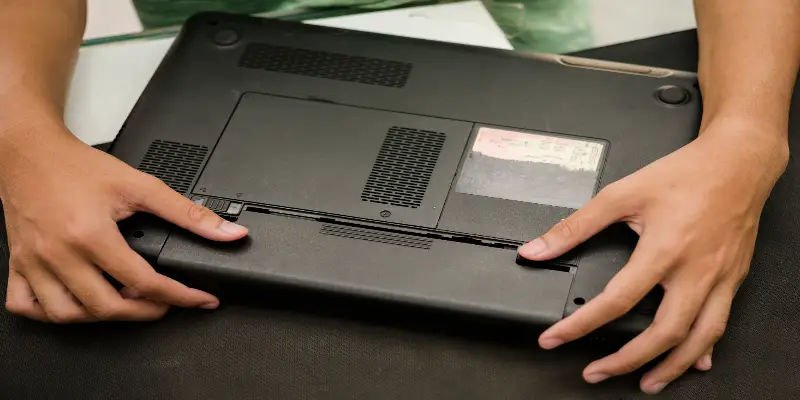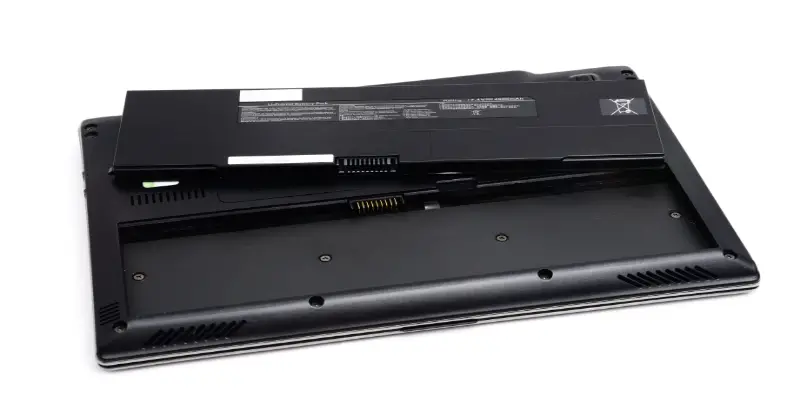Disclaimer: This post may contain affiliate links, meaning we get a small commission if you make a purchase through our links, at no cost to you. For more information, please visit our Disclaimer Page.
We all know that there are many different types of laptops. One of the major differences is that some laptops have a removable battery, which means you can easily take it out and replace it with a fully charged one. Is it possible that your laptop runs slower without a battery?
When plugged to direct AC and without a battery, a laptop’s performance and processor speed is not affected and should run as usual. However, it’s not a miracle to notice slow performance for some laptop models. Using a laptop this way immediately turns it off when the power plug gets turned off.
Table of Contents
Will a laptop work without a battery?
Laptops aren’t meant to be used without their batteries, but most will work even when the battery gets plugged out. Laptops will, however, need you to keep them plugged to power all through, and when plugged out, they turn off.
There are some cautions you to follow:
Firstly ensure that you use the laptop’s original power adapter. Power variation risks damaging laptops components, but when the battery is there, it can help regulate this. Power variations destroy the computer’s motherboard causing damages to laptop components.
When living in areas with usually power variations or with a faulty current circuit, always ensure you use the laptop with a battery connected and not use a UPS. That way, you prevent damaging your laptop’s components in case of anything.
Secondly, always remember to remove the battery when the laptop is off and when unplugged to power. In addition, when using a laptop that’s connected to direct AC without its battery, don’t touch battery contacts.
Lastly, never suddenly remove the power cord when using a laptop without its battery. It will cause damage to the laptop’s components, and some software may be affected too.
Battery Care
Removing the battery and using direct AC could have been a good idea to maximize battery lifespan some years ago. But with the improvement and advancement in battery current, there is no harm in keeping it connected to a charger for long.
However, if you still want to use or store the battery to increase its lifespan, always ensure that you store your battery while charged to at least 40%. Also, you will need to do a full charge and discharge cycle periodically.
To avoid removing the battery and fear of destroying the battery, avoid heating the machine.
Does the laptop run slower without a battery?
Using a laptop without its battery connected and provided it’s connected to direct AC, the performance should be as usual, however for some laptop models; the performance speed does reduce. The only problem is that there is no safety net, and when external power gets removed, it will turn off.
Some laptops will run slower since the settings are set in a way to reduce the CPU voltage when connected to direct AC, and the battery is removed. Hence when this setting is adjusted, the running speed will go back to normal.
For other laptops, they consume more peak power than those provided by the AC adaptor. The extra power is sourced from the battery. The laptop without its battery, as we have seen, should run without any problems in terms of performance; although doing this seems safe, some risks include:
1. Damage to the motherboard
The motherboard is a component in the laptop that generally receives current when you turn on your computer. It ensures that all other components get stable current. Laptop batteries store charge and ensure that this first current is balanced and stable for the motherboard.
When the battery is not there, the sudden current from the AC adaptor may not be stabilized and will hence risk damaging the motherboard by giving it excess current.
2. Risk damaging the processor, hard disk, RAM, and more
As earlier stated, the power voltage may vary, causing the component to stand a high chance of damage. The voltage variance reduces the lifespan drastically to components such as the hard disk.
When connected to direct AC, there are risks of power going off; this results in more harmful damage to the hard disk, especially if it was reading or writing data. Sadly you risk complete damage to the hard disk if the power goes off and on frequently and you are not connected with a battery.
3. Destroying the inverter system
The inverter system is located at the battery and helps regulate the amount of voltage getting into the laptop. When the battery is removed, it will not function as it’s supposed to; hence the power voltage that gets into the computer is not regulated and likely to vary, causing damage to the laptop components.
4. Power outage damage
When the power goes off without any warning, turn the computer off. You may not feel the effects of this immediately. This sudden turn-off risks damaging components such as the hard disk and the processor due to the sudden stop of its work.
If it occurs frequently, you risk causing permanent damage to the hard disk. Another risk is that you risk losing data, especially if you had not saved your data.
5. Risks of short circuit
An electrical short circuit can happen anytime, whether it is with a battery in contact or not. However, the risks and chances for such an accident to happen are higher in the absence of the battery and connected just to the direct power supply.
In case of a short circuit, it will not only crush your laptop, but it has more advanced effects in that it could burn down the laptop and also anything around the computer.
How can I make my laptop run faster without a battery?
Laptops are not designed to function with their batteries out, and hence slow running behavior may be something to come across when using your laptop. Without the battery, a laptop may not handle a power spike in the CPU when it goes to active state from halted state.
Laptop batteries act as a cushion to make up for power shortfalls. In case the laptop is running slow, you will need to try using a different adaptor. Maybe the adaptor is underrated; hence you should try using a bigger one.
A laptop may also run slow when the BIOS is set in a way that it runs slower when the battery is removed. To change the BIOS setting, press the F2 button when the boot-up process begins and before the windows logo appears.
Choose “Power Management,” then proceed to change battery and AC power to “Disable.” In addition to saving more booting time, select “Performance Options,” you should see “Hard Drive Noise Level.” If it’s set at “Quiet,” change it to “Performance” for faster boot time.
If these options are not listed in BIOS, you will need to flash your computer to the latest updated version. Apart from that, also check the windows power setting. Press the start button, then the control panel, and finally to Power options to navigate to the Windows power setting.
In case category view is turned on, you will need to change to “view by,” an option at the right upper corner. When using Windows XP, “Home/Office Desktop” should be your choice. With Windows 7 and Vista, select “change plan settings” to get an active power plan and also set it, making sure you get all processing cycles your CPU can give.
You will also be able to get maximum performance in a laptop when it’s plugged into power and doesn’t have its battery by ensuring that you run few or no background applications. It will enable you to get maximum speed and CPU space.
Conclusion
As evidenced above in the article, a laptop can function perfectly fine even when the battery is removed, provided it’s connected to AC using a charger. However, doing this is not advisable since there are risks such as loss of data in case power goes off and damage to laptop components.
Those that have damaged batteries are advised to buy new ones. Those trying to lengthen battery lifespan should read more on how to improve battery lifespan rather than use their laptops without the battery.


